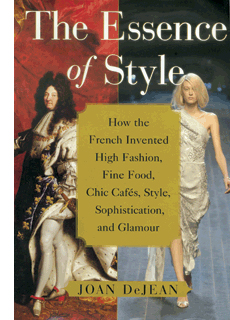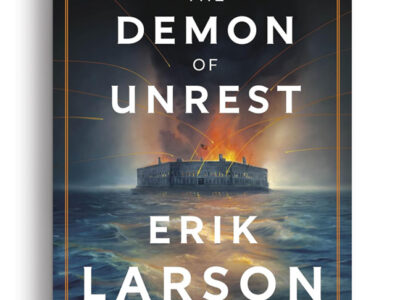The Sun King’s real legacy.
By Julia M. Klein

THE ESSENCE OF STYLE:
How the French Invented High Fashion, Fine Food, Chic Cafés, Style, Sophistication, and Glamour
By Joan DeJean, faculty. Free Press, 2005. $25.00.
Versailles wasn’t just a palace; it was the embodiment of an ideal. So suggests Dr. Joan DeJean, Trustee Professor of French at Penn, in The Essence of Style: How the French Invented High Fashion, Fine Food, Chic Cafés, Style, Sophistication, and Glamour. During Louis XIV’s reign, “make it chic and make it cher” were the ground rules for everything from mirrored halls to diamond-studded coiffures. The conventional historical account of the era says its aristocratic excess helped pave the way for the French Revolution. But gazing through the prism of culture rather than politics puts a different gloss on the matter.
According to DeJean, the legendary predilections of the Sun King fostered not only new fashions but new businesses, as well as cultural innovations that have rippled across the ocean and the centuries. In The Essence of Style, DeJean argues that such late-17th-century French creations as haute couture and haute cuisine continue to define France in the popular imagination. And not only France: They are inseparable, she writes, from our contemporary notions of elegance and luxury. In fact, Louis XIV’s reign may well have been, she argues, “the most crucial period ever in the history of elegance, élan, and luxury goods.”
These are weighty claims—and it’s to DeJean’s credit that she explores them in a manner devoid of ponderousness. The Essence of Style is nearly always the essence of lucidity, and it is often entertaining to boot. Eschewing footnotes and academic prose, DeJean breezily covers a wide range of phenomena: footwear, hairdos, dress styles, fashion reporting, the origins of French cuisine, perfume, the illumination of the city, the spread of coffee and café culture, mirrors, antique markets, and even the portable umbrella.
Particularly vivid is her account of the mirror-making rivalry between Venice and Paris, a competition that she says involved machinations worthy of Don Corleone. (DeJean occasionally labors to supply contemporary analogies, as though her historical narrative weren’t compelling enough on its terms.) Mirror-making reached its 17th-century apogee in the glass-blowing factories of Murano, she tells us, but Louis XIV was determined that France should have its own mirror industry. So he initiated what DeJean describes as “the first decidedly hostile takeover,” involving “industrial espionage of the highest order.”
The competition apparently began in the 1660s, when the monarch was spending the equivalent of $1 million a year importing mirrors from Venice. His finance minister, Colbert, had a better idea: luring Venice’s top mirror-makers to France. While Venice threatened and blustered, France offered enticements to the defecting craftsmen that included generous dowries and a personal visit from the king. Forgery, kidnapping, and a factory shoot-out upped the ante still further. With France winning the battle, the Venetians resorted to poisoning the expatriate mirror-makers, and imprisoning and executing others on the brink of defection.
By 1672, France had nevertheless achieved mirror independence—and a decade later, the public was welcomed to the now-famous Hall of Mirrors at Versailles. Ironically, DeJean writes, the hall actually was decorated with groupings of small mirrors, made with old-fashioned glass-blowing techniques. It was only in 1687 that Bernard Perrot—a naturalized Italian—developed the metal-pouring technique that would revolutionize mirror-making and make far larger mirrors possible.
The invention of what we now know as classic French cuisine—whose beginnings DeJean dates from a 1651 cookbook titled Le Cuisinier français (The French Chef)—also exacted some casualties. DeJean begins this chapter, “From the French Cook to Crème Brûlée: How Cooking Became Haute Cuisine,” on a modern note, with an account of the Burgundian chef Bernard Loiseau’s suicide in 2002—spurred, it was said, by his fear that the vaunted Michelin Guide was about to remove the third star from his restaurant, La Côte d’Or. As it happens, he was wrong.
But such extreme culinary anxiety is hardly a 20th-century phenomenon. DeJean introduces us to the 17th-century chef François Vatel, who was charged with preparing a Friday banquet for the visiting king. Fearing that the supply of seafood would be inadequate, he “propped his sword against the door” and drove it through his heart—the victim of an apparent misunderstanding and his own perfectionism.
There’s a ferocity to these tales that suggests just how seriously the French, now and then, take their pleasures. But mostly DeJean’s account has the sparkle and fizz of a finely faceted diamond or a glass of Champagne—two other luxuries she credits to 17th-century France.
Julia M. Klein is a cultural reporter and critic in Philadelphia who writes for The New York Times, Mother Jones, The Chronicle of Higher Education, and many other publications.




